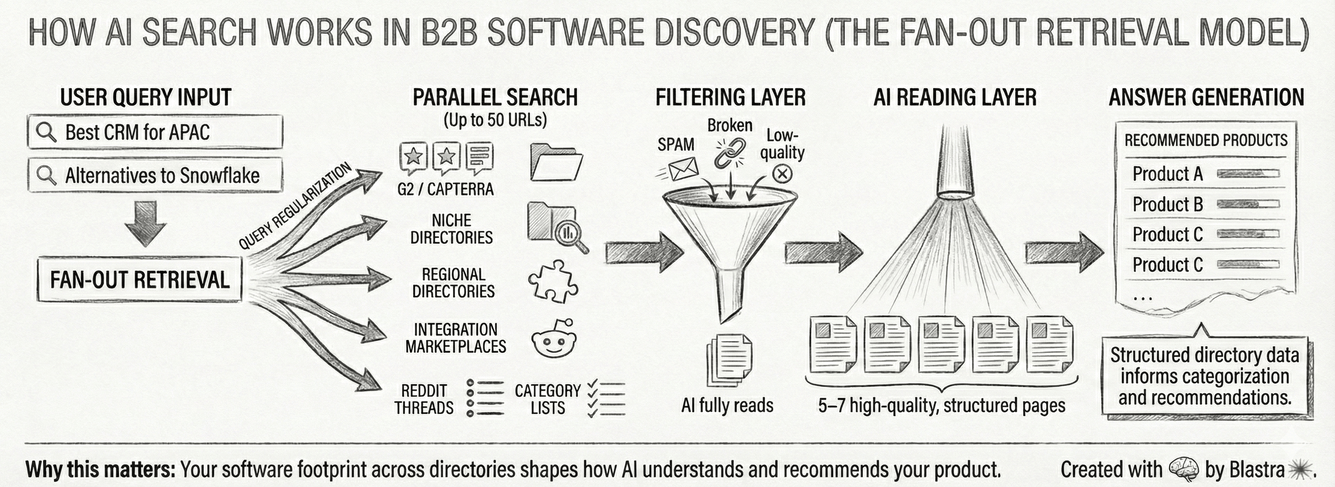For years, most B2B software vendors treated directories outside of G2 and Capterra as peripheral marketing assets—useful for backlinks, sometimes helpful for credibility, but not central to discovery. In the Google-first era, that mindset made sense. Visibility depended on ranking in a small number of high-authority places.
But AI-powered discovery has changed how products are found. Not because buyers suddenly browse niche directories more often, but because AI systems adjust answers based on user context—location, industry, role, company size, and even previous search intent.
A buyer in Singapore may prompt AI to check APAC-focused directories. A cybersecurity researcher in Germany may trigger results from DACH-specific security indices. A martech buyer in Brazil may unknowingly pull in data from a LATAM marketing tools catalog.
AI does not rely on a single global set of "top" directories. It relies on context, and context influences which sources AI retrieves during its internal search process.
This is why long-tail, niche, and regional software directories—once considered insignificant—now play a meaningful role in how AI understands your product and your competitive landscape.
At Blastra, we define this new reality as Software Footprint Management: maintaining consistent, accurate product information across the full ecosystem of directories so AI can correctly interpret, categorize, and recommend your software.
AI Discovery Has a Different Logic Than Human Search
A human buyer performs a linear search journey: skim a Google results page, open a few links, skim again, and maybe check G2. AI retrieval does not resemble this pattern.
Research from Profound NYC in their Zero-Click 2025: The Machine Customer Era study shows that AI systems expand a single user query into multiple related searches—a process known as "query regularization." A normal question can produce five to seven parallel sub-queries, each explored independently.
These queries yield dozens of URLs, often fifty or more, pulled from across the web—not just the first page of Google.
From this pool, AI filters out pages based on several trust signals: structure, consistency, depth, and freshness. Only a handful of pages—typically five to seven—are fully read before the model synthesizes an answer.
And critically: Even identical questions can produce different results, depending on phrasing, geography, user history, and the model's internal state.
This variability means no single research study can definitively map how AI retrieves information. But the directional pattern is clear: AI systems tend to elevate structured, comparable, and frequently updated sources—a precise description of B2B software directories.
Why B2B Software Directories Fit AI's Retrieval Patterns
Software directories provide something AI systems can interpret with high confidence: consistency.
Every listing follows the same predictable format:
- category
- feature lists
- integration lists
- pricing fields
- screenshots
- metadata
- alternatives and competitors
- user reviews
This structure creates an ordered, comparable representation of software products. Vendor websites vary wildly in layout and vocabulary. Directories do not.
Freshness also matters. According to Profound NYC, recently updated content may carry up to three times the weight of stale pages during retrieval.
Semantic URLs matter too; pages like "/best-crm-for-startups" show higher citation likelihood in AI-generated answers.
Complementary findings from Ahrefs' AI SEO Statistics also show that AI tends to cite structured, category-based, list-based, or comparison-based URLs more than generic content pages.
Directories naturally satisfy these conditions. That makes them appealing retrieval candidates for AI systems.

The Trust Layer: Moderation and Crowd Validation
Another reason directories align naturally with AI retrieval is the human-in-the-loop verification they offer. Most major and mid-tier directories invest in:
- review authentication
- moderation
- spam detection
- consistent categorization
AI systems treat these human verifications as credible signals.
A parallel example is Reddit, whose community moderation makes it a high-quality source for AI training and retrieval—a dynamic discussed on Lenny's podcast with Ethan Smith, CEO of Graphite, the leading SEO growth agency.
Niche directories are smaller and therefore rarely appear in research datasets, but they share the same advantages: authenticated data, real user input, and structured product schemas.
Even without scale, they provide valuable contextual signals during AI fan-out retrieval.
How AI Learns What Your Product Actually Is
To recommend software, AI must understand:
- category placement
- competitors
- features
- integrations
- vertical relevance
- ideal customers
- use cases
- customer sentiment
Your homepage cannot provide all this information. Directories—major, niche, vertical, and regional—fill these gaps.
AI systems pull signals from:
- review platforms such as G2 (Gartner Digital Markets) (2025 Buyer Behavior Report)
- horizontal directories like SourceForge and SaaSHub
- cybersecurity, martech, devtools, and AI tool directories
- regional catalogs across APAC, LATAM, India, and Europe
- integration ecosystems and partner marketplaces
- long-tail listings unique to certain industries or geographies
A competitor with complete presence across these ecosystems provides AI with a clear, consistent set of signals. A vendor with missing or outdated listings does not.
That difference directly affects how the model represents each product in a recommendation task.
Why Software Footprint Management Is Now Essential
According to the G2 Buyer Behavior Report 2025, generative AI tools have become the most influential factor in software shortlist decisions—more than analysts, websites, or salespeople.
If AI determines whether a buyer ever encounters your product, then your footprint across directories becomes part of your AI visibility infrastructure.
A strong software footprint ensures that:
- AI sees accurate, consistent data about your product
- your category and competitive context are clear
- integration and feature signals align across sources
- regional directories reinforce your positioning
- structured metadata supports correct interpretation
Directories are no longer about backlinks. They are about context, classification, and discoverability in an AI-driven world.
The companies that maintain a consistent footprint across the entire directory ecosystem will be the ones AI understands—and recommends—first.
You Might Also Like
- Building Competitive Advantage Through Strategic Directory Presence - How to build an enduring advantage through strategic directory presence
- How to Get Your Software Ranked on G2 (and Why Invest in It at All) - Master G2's scoring algorithm and earn those coveted badges
- How to Win Customers by Learning from Your G2 Competitor Reviews - Turn competitor reviews into your growth advantage

